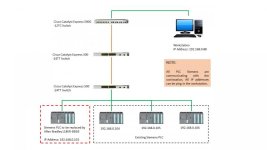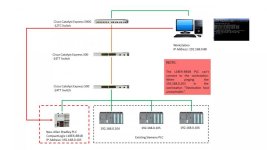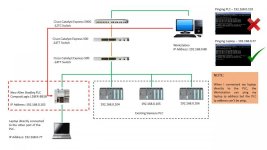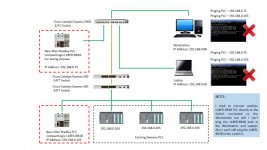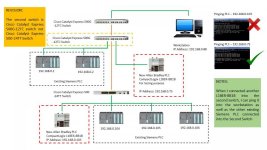I found a rockwell knowledgebase document regarding Cisco and Rockwell Automation Hardware IP device tracking. The switch used is Cisco Catalyst 500 and IPDT might be implemented.
Below is the content of the document.
568750 False Duplicate IP detection on Ethernet modules when used with Cisco switches
Problem
When Rockwell Automation EtherNet/IP modules are connected to a subnet containing Cisco switches with "IP device tracking" (IPDT) enabled, the modules may go into a
duplicate IP address state after a restart/reset.
Environment
Any layer two networks that contain both Rockwell Automation EtherNet/IP modules and Cisco switches running IPDT.
IPDT is much more likely to be implemented on Cisco switches as of August, 2013 because of a behavior change which enables this command if any feature which
requires it is enabled.
This behavior change also removes the ability to turn off IPDT without first turning off any features which require IPDT.
The Stratix line of switches will not have “IP device tracking” enabled by default until a permanent solution is in place.
Cause
The IPDT feature sends probe ARP packets with a source IP address of 0.0.0.0., the source MAC ID of the switch, and the target IP and MAC ID for the device being probed
to check that it is still connected and responsive.
When a device becomes disconnected, and then is reconnected within the configurable IPDT timeout period, probe ARP packets may be received by a Logix Ethernet
module at the same time as it is in its Address Conflict Detection mechanism. If this happens, the EtherNet/IP module will immediately go into a duplicate IP state, and
stop communicating.
IPDT when activated on a Cisco switch will try to probe for every IP connected on the subnet, regardless of whether it is connected to that switch or not.
Testing has shown that this affects the majority of Ethernet modules sold by Rockwell Automation.
Solution
Cisco is continually updating the latest workarounds.
Here is a link to Cisco’s technote:
http://www.cisco.com/c/en/us/support/docs/ip/addressresolutionprotocolarp/
118630technoteipdt00.
html
Workaround
Several workarounds to this issue exist. They all make suggestions using Cisco IOS commandline
interface commands.
Workaround 1
Architect manufacturing zone subnets such that:
1. IPDT is explicitly disabled on every trunk port with the following command:
Hostname (configif)#
ip device tracking maximum 0
2. IPDT probe delay is manually configured on any access port connected to a Rockwell Automation Ethernet module with the following command:
Hostname (config)# ip device tracking probe delay 10
Workaround 2
If the switch in question has an administration IP (SVI) configured on the subnet/VLAN in question the Cisco CLI command:
Hostname (config)# ip device tracking probe usesvi
will insert the administration IP into the source IP in the IPDT packet. This packet will not impact Address Conflict Detection operation.
Workaround 3
Disable IPDT on any Cisco switch ports with IPDT enabled that subsequently connect to a Rockwell Automation Ethernet module with the following command:
Hostname (configif)#
ip device tracking maximum 0
Do you guys encounter such??
